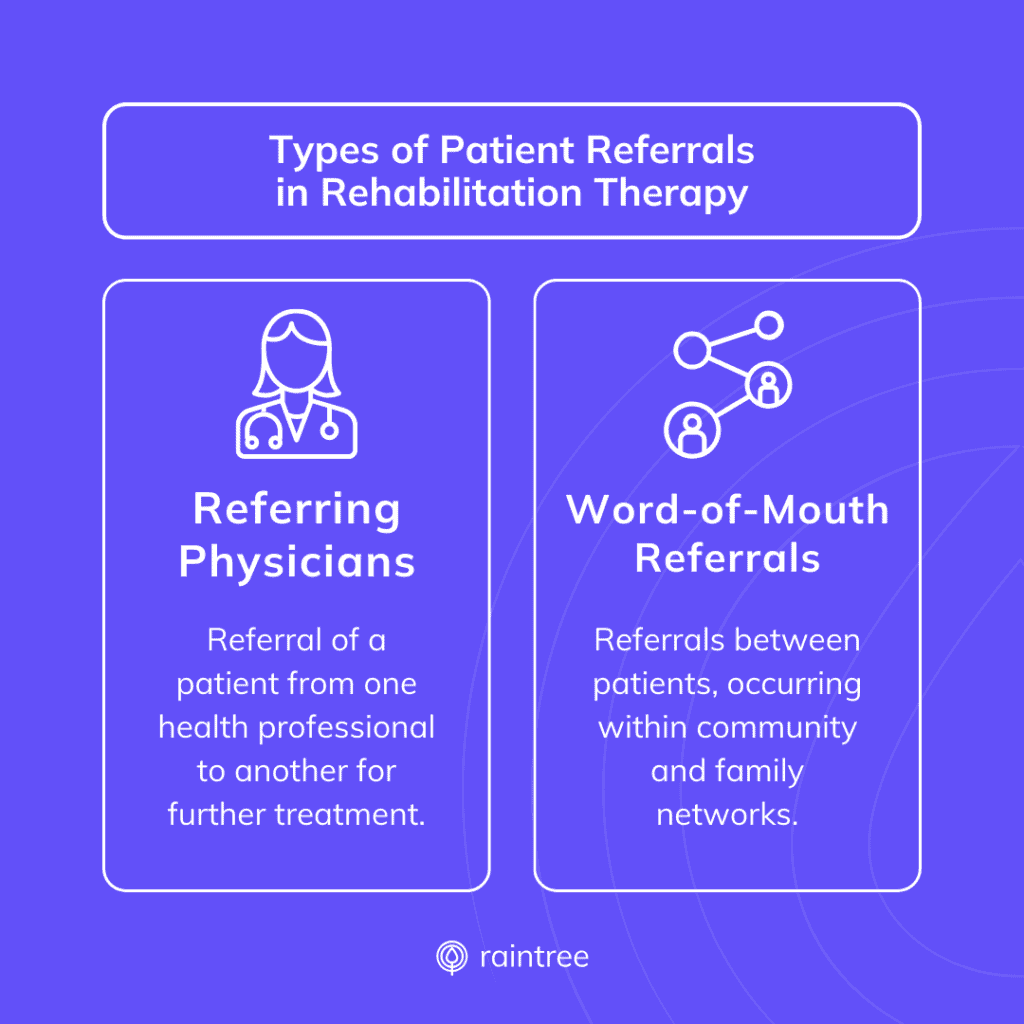Imagine a new patient walks through your door, guided by the positive endorsement of someone they trust. Or better yet, referred by someone who’s already benefited from your physical therapy services!
These “warm leads” come with built-in trust and a pre-existing belief in your therapists’ ability to heal. And this is the real power of patient referrals.
Set yourself up for success with these practical strategies to increase patient referrals to your physical therapy clinics.
How to Get More Physical Therapy Referrals
Practice owners and savvy marketers can drive new referrals in many ways. The key is to think outside the box: from building partnerships with local gyms and health organizations, to building community on social media and in-person events.
Read on to find tips about turning your practice into a patient magnet by incorporating both common and creative referral strategies. Referral boosting strategies include:
-
Building relationships with local physicians and specialists to increase physician referrals.
-
Generating word-of-mouth referrals for direct access patients.
-
Measuring and continually improving your referral marketing strategy.
-
Identifying untapped opportunities to reach new patients.
-
Utilizing physical therapy referral management software.
Increasing Physician Referrals to Your PT Practice
Partnering with primary care physicians and specialists is one of the most straightforward ways to generate more referrals.
Why? Because physicians like orthopedic surgeons, general practitioners, and internal medicine specialists can grant you access to vast pools of potential patients who are already engaged in care. Fostering these clinical relationships over time can provide a steady flow of new revenue to your practice.
Plus, when patients receive clear, unified guidance from their doctor and physical therapist, they’re more likely to stick to the treatment plan, leading to faster recovery, improved outcomes, and higher patient satisfaction.
Consider these tips to position your practice as the go-to referral for quality care:
- Prioritize building authentic, outcome-focused relationships, ensuring mutual respect and shared patient interests.
- Reach out to local physicians and specialists who treat your target audience, not only primary care physicians,
- Avoid unethical referral practices that can compromise patient-centric care.
- Keep referring physicians informed about the status of their patients (e.g. sending automatic confirmation when the referred patient makes their first appointment).
💯 Practical Advice
Make the physician referral process as easy as possible. Providers may avoid referring patients to you if it’s too time-consuming or inconvenient. eReferrals save time for everyone!
Inspiring Word-of-Mouth Referrals
Nielsen’s 2021 Trust in Advertising Study found that 88% of consumers trust personal recommendations more than any other form of advertisement.
Okay, that might not be surprising. After all, word of mouth referrals and online reviews from current patients have been a long-trusted source of info for prospective patients. But today, with the rise of consumer healthcare and direct access in physical therapy, sharing authentic client referrals and testimonials is an essential for any healthcare marketing campaign.
Here are a few tactics to increase word-of-mouth referrals:
Be the first PT practice that comes to mind by being visible in your community and online. (We discuss ways to do this below!)
Just ask! During appointments, therapists can prompt satisfied patients to spread the word, and explain how. Many patients would be happy to share their positive experiences but may not think about it or know how to get the ball rolling.
- Keep it simple with a short, accessible form that allows patients to send an email inviting their friends and family to connect with your practice.
- Make your patient-to-patient referral program mutually beneficial. People may be more likely to refer friends as part of a referral rewards program with discounts on classes, a massage coupon, raffle prizes, or other simple incentives.
Measuring the Success of Your Referral Marketing Tactics
Implementing different referral generation methods is great, but you need to know if they’re actually working. That’s why you need to measure the effectiveness of your efforts to understand what’s working (or not working), while also tweaking and tailoring your strategies to increase patient referrals over time.
Regularly assess your progress by keeping an eye these metrics:
- Referral Sources. Learn which channels or referrers are generating the most business.
- Referrals Received. Assess trends and potential growth opportunities.
- Return on Investment (ROI). Compare revenue generated from referred patients vs. your investment in referral marketing or incentive programs.
- Patient Lifetime Value (LTV). Evaluate the long-term value of patients acquired through referrals.
Identifying Untapped Opportunities to Reach New Patients
By venturing beyond your clinic walls and engaging with the wider community, you can attract new patients, build trust, and fuel your practice’s growth organically.
Go Where Your Patients Are
Direct access and consumer trends in healthcare have opened a direct line to new patients. Make sure they land on your doorstep, not someone else’s.
Think about where your target audience spends time and what businesses have earned their trust. For example, if your practice focuses on athletes, consider building relationships with local universities, gyms, and personal trainers.
And don’t forget the internet! Online healthcare marketplaces like ZocDoc and the Medicare provider database are examples of sites where patients are actively searching, waiting to find you.
Finally, bolster your online presence with glowing reviews, engaging social media, and a user-friendly website.
Engage and Educate Potential Patients
There are plenty of ways to market to new patients while also promoting the value of physical therapy itself.
For instance, practices can collaborate with local businesses by offering educational sessions on topics like injury prevention and ergonomics. Collaborating with running stores, fitness clubs, health fairs, marathons, school events, or other venues that cater to your ideal patient can be an ideal way to increase your visibility.
“Edutainment” can also make your practice stand out online. Show off the personalities and expertise of your staff with educational videos, webinars, podcasts, blogs, or newsletters. Done well, informative—and above all, valuable—content can help build a following on social media platforms and drive organic visitors to your website.
Growing and Connecting With Health Systems
In outpatient physical therapy, the most valuable partnership models can be with inpatient hospital systems. Well-established PT practices or enterprise groups may form referral partnerships or joint ventures with hospital systems. These opportunities are an invaluable way to generate referrals and growth for your practice, but they’re far beyond the scope of your marketing efforts.
Partnership with health systems and hospitals is a strategy that can enable value-based care and a mutually beneficial long-lasting referral system; at the same time, they also create increased regulatory complexity, require interoperable systems, and demand operational excellence.
Using Physical Therapy Referral Management Software
Once the leads are flowing in, it’s time to bring the patients to your practice.
But it’s easier said than done. The hassle of manually tracking and following up with referrals can slow your efficiency and put a strain on your front desk. And the gap between contact form and first-contact can turn a warm lead cold, quick.
To turn patient referrals into new patients, modern physical therapy practices embrace digital intake and patient engagement tools, including:
- eReferrals
- Lead tracking dashboards
- Prior authorization and eligibility verification solutions
- Automated patient communications and updates to referring physicians
- Waitlist management automation
- Self-service kiosks
Increase Patient Referrals and Drive Growth for Your Practice
Are you ready to generate more physical therapy referrals, create a great patient experience, and nurture sustainable growth at your practice?
Raintree is the preeminent platform for enterprise and mid-sized therapy provider organizations, providing solutions in patient engagement and communications, clinical documentation, billing and revenue cycle management (RCM), and business intelligence and analytics for physical therapy, occupational therapy, speech therapy, and ABA across all treatment settings. From pediatric to geriatric practices, Raintree clients make up over 2,500 implementations nationwide and more than 25,000 users daily. Request a demo and meet your new partner in success!
Read the Guide:
A Roadmap for Effective, Patient-Centered Marketing
Frequently Asked Questions
Are referrals needed for physical therapy treatment?
Not necessarily. Traditionally, physical therapy patients would receive a physician referral and prescription to begin outpatient physical therapy treatment. However, the physical therapy market has changed over the years. Direct access laws in all 50 states have made it easier for patients to initiate physical therapy treatment without needing to schedule an appointment with their primary care physicians. However, some insurance payers still require physician referrals, and generational trends in patient preferences may affect whether an individual seeks out advice from a PCP or self-refers to physical therapy.
What are the obstacles to effective referral management?
Challenges in the referral management process include communication issues (e.g. lack of follow-up between physicians), burdensome administrative processes and delays, patient non-adherence, and healthcare data silos. Referral management challenges can lead to patients falling through the cracks, causing disruption to necessary health services. This is why "closing the referral loop" is so important to the future of health care delivery.
How do you build patient referrals?
Self-referral allows patients to seek specialized care without intermediaries and affords them freedom and control over their healthcare journey. Some studies indicate other benefits like lower overall healthcare utilization and less time off work compared to care directed by a primary care physician. Additionally, a recent literature review concluded that direct access is an effective alternative to physician-first care in terms of "patient safety, satisfaction, access to care, efficiency, healthcare utilization, and potential cost savings."
How do I get more referrals from existing patients?
First and foremost, you can inspire more referrals from existing patients by delivering outstanding care and a great patient experience. The most impactful referrals and reviews will come from individuals who understand the value of your services and can speak authentically about their experience. Practices can encourage word of mouth referrals and reviews by asking for them directly, sending automatic emails or texts, or starting a patient-to-patient referral incentive program.




